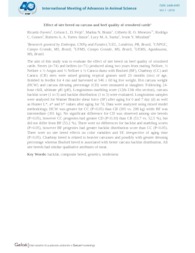Effect of sire breed on carcass and beef quality of crossbred cattle.
Effect of sire breed on carcass and beef quality of crossbred cattle.
Summary: The aim of this study was to evaluate the effect of sire breed on beef quality of crossbred cattle. Steers (n=74) and heifers (n=71) produced along two years from mating Nellore, ½ Nellore x ½ Angus and ½ Nellore x ½ Caracu dams with Braford (BF), Charbray (CC) and Caracu (CR) sires were raised grazing tropical grasses until 20 months (mo) of age, finished in feedlot for 4 mo and harvested at 546 ± 60 kg live weight. Hot carcass weight (HCW) and c rcass dressing percentage (CD) were measured at slaughter. Following 24- hour chill, ultimate pH (pH), Longissimus marbling score (12th-13th ribs section), carcass backfat score (1 to 5) and backfat distribution (1 to 3) were evaluated. Longissimus samples were analyzed for Warner Bratzler shear force (SF) after aging for 0 and 7 day (d) as well as Hunter L*, a* and b* values after aging for 7d. Data were analyzed using mixed model methodology. HCW was greater for CC (P<0.05) than CR (305 vs. 288 kg) while BF was intermediate (301 kg). No significant difference for CD was observed among sire breeds (P>0.05), however CC progenies had greater CD (P<0.10) than CR (53.7 vs. 52.5 %), but did not differ from BF (53.2 %). There were no differences for backfat and marbling scores (P>0.05), however BF progenies had greater backfat distribution score than CC (P<0.05 ). There were no sire breed effects on color variables and SF, irrespective of aging time (P>0.05). Charbray breed is related to heavier carcasses and possibly with greater dressing percentage whereas Braford breed is associated with better carcass backfat distribution. All sire breeds had similar qualitative attributes of meat.
Publication year: 2016
Types of publication: Abstract in annals or event proceedings
Unit: Embrapa Beef Cattle
Observation
Some of Embrapa's publications are published as ePub files. To read them, use or download one of the following free software options to your computer or mobile device. Android: Google Play Books; IOS: iBooks; Windows and Linux: Calibre.
Access other publications
Access the Agricultural Research Database (BDPA) to consult Embrapa's full library collection and records.
Visit Embrapa Bookstore to purchase books and other publications sold by Embrapa.

